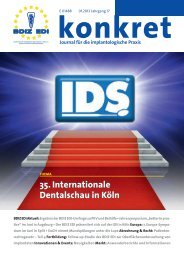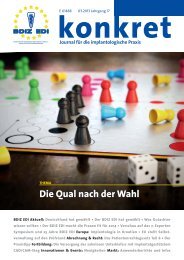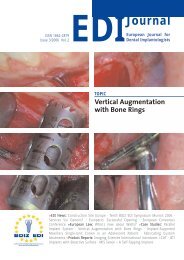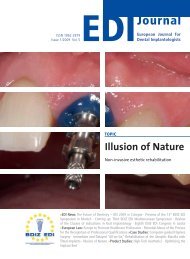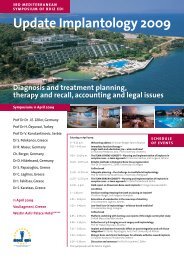EDI - European Association of Dental Implantologists
EDI - European Association of Dental Implantologists
EDI - European Association of Dental Implantologists
Create successful ePaper yourself
Turn your PDF publications into a flip-book with our unique Google optimized e-Paper software.
70 <strong>EDI</strong><br />
Case Studies<br />
were also required to refrain from wearing a denture<br />
for at least two weeks after implant placement to<br />
facilitate s<strong>of</strong>t-tissue healing [25]. After the submerged<br />
healing period, a second intervention to uncover the<br />
implants was required. The original concern was that<br />
any implant micromovement might lead to fibroustissue<br />
encapsulation <strong>of</strong> the implant as a reparative<br />
response to physical trauma, resulting in failure to<br />
achieve osseointegration [53-55]. While the importance<br />
<strong>of</strong> the contribution by Brånemark and coworkers<br />
[25] should not be underestimated given the high<br />
success rates and predictable results that have been<br />
documented for more then 30 years, it is important to<br />
note that delayed loading was an empirical principle<br />
that had never been experimentally demonstrated.<br />
The current trend is not to consider implant movement<br />
per se as detrimental to osseointegration, but<br />
rather to consider a threshold <strong>of</strong> acceptable micromovement.<br />
It has been suggested that micromovement<br />
<strong>of</strong> 150 μm or more is excessive and therefore<br />
deleterious for osseointegration, while micromovement<br />
<strong>of</strong> less <strong>of</strong> 50 μm seems to be tolerated [53-55].<br />
During the 1970s, Ledermann [31] introduced the technique<br />
<strong>of</strong> immediately splinting and loading four<br />
transmucosal implants in the edentulous mandible<br />
with a bar-supported overdenture. The underlying<br />
theory was that rigid splinting <strong>of</strong> implants in the<br />
dense bone <strong>of</strong> the mandibular symphysis would prevent<br />
implant micromovement and allow effective<br />
healing and osseointegration under immediate-loading<br />
conditions. Since then, an increasing number <strong>of</strong><br />
publications on immediate loading have been published<br />
citing high success rates in mandibular and<br />
maxillary sites for single-tooth replacement, partial<br />
fixed restorations and full-arch prostheses [31-52].<br />
Most authors agree that good bone quality, primary<br />
stability with insertion torques up to 35-40 Ncm<br />
and rigid splinting <strong>of</strong> implants are important factors<br />
for the long-term survival <strong>of</strong> implants [45]. Several<br />
studies by Piattelli and coworkers [41-43] on both animals<br />
and humans have demonstrated that not only<br />
may immediate loading lead to successful osseointegration,<br />
but it may also increase the quantity <strong>of</strong> bone<br />
in direct contact with the implant surface.<br />
The dense structure <strong>of</strong> cortical calvarial bone grafts<br />
[21-24], which gives implants a high level <strong>of</strong> primary<br />
stability, and the immediate rigid splinting <strong>of</strong> fixtures<br />
with a screw-retained provisional restoration<br />
allowed us to immediate load implants inserted in<br />
previously grafted maxillary sites. The Teeth-in-an-<br />
Hour concept along with the Procera 3D planning<br />
s<strong>of</strong>tware (Nobel Biocare AB, Gothenburg, Sweden)<br />
allowed us to provide patients with fixed well-functioning<br />
restorations on implants in a single one-hour<br />
procedure. By using a custom template created from<br />
the primary CT scan, the provisional teeth can be fabricated<br />
before the implant procedure and inserted at<br />
the same time the implants are placed [58-62]. This<br />
system <strong>of</strong>fers more accurate and safer positioning <strong>of</strong><br />
dental implants via flapless surgery, reducing postoperative<br />
pain, oedema and bleeding [58-62].<br />
Conclusions<br />
The clinical results reported here have shown that<br />
immediate loading is feasible even in grafted anterior<br />
maxillary sites, shortening treatment times in<br />
patients with bone defects.<br />
The therapy is a clinical option even in correctly<br />
diagnosed patients with inadequate bone structure,<br />
provided that a proper reconstructive treatment plan<br />
is made. Patients expect good aesthetic results as<br />
much as they expect functional rehabilitation.<br />
Implant treatment in the aesthetic zone following<br />
injuries or the resection <strong>of</strong> a tumour present both<br />
aesthetic and functional challenges and require the<br />
use <strong>of</strong> the entire scientific, biological and technological<br />
armamentarium, from diagnosis to final therapy.<br />
An accurate CT scan showing the available bone<br />
supply plus the correct identification <strong>of</strong> viable<br />
implant positions using state-<strong>of</strong>-the-art diagnostic<br />
s<strong>of</strong>tware constitute an appropriate approach toward<br />
a three-dimensional determination <strong>of</strong> the bone<br />
quantity required for the implants and their superstructures.<br />
Decisions related to harvesting, donor<br />
sites and bone-block sizes can be made subsequent<br />
to the virtual planning phase.<br />
A computer driven approach seems to be a new<br />
“gold standard” for implant placement, as it assists in<br />
identifying the correct position <strong>of</strong> the implant and<br />
prosthetic platform, respecting adjacent anatomical<br />
structures and creating a correct emergence pr<strong>of</strong>ile <strong>of</strong><br />
the final restorations. In addition, this clinical approach<br />
<strong>of</strong>fers an opportunity to perform a safe and accurate<br />
flapless procedure with favourable outcomes.<br />
The use <strong>of</strong> cortical multi-layered split calvarial bone<br />
grafts with a very low resorption rate and highly dense<br />
structure, high primary stability and rigid connection <strong>of</strong><br />
the implants and accurate computer-guided planning<br />
and implant insertion are the keys to success. However,<br />
more studies and randomized clinical trials are needed<br />
to asses the predictability <strong>of</strong> the procedure.<br />
Contact Address<br />
Dr Alessandro Acocella<br />
Via Dante da Castiglione, 16/A Cercina, Sesto Fiorentino,<br />
Firenze, 5010, ITALY<br />
Phone: +39 333 2317982 (cell.)<br />
alessandroacocella@yahoo.it<br />
A list <strong>of</strong> references<br />
will be supplied by<br />
the editorial <strong>of</strong>fice<br />
on request.




